Patria: Historical Name, Vintage Look, New Technology, And Flyback Column Wheel Chronograph
Louis Brandt is a name that most watch aficionados know: Monsieur Brandt founded a workshop in La Chaux-de-Fonds, Switzerland in 1848 that would have the honor of later becoming today’s Omega.
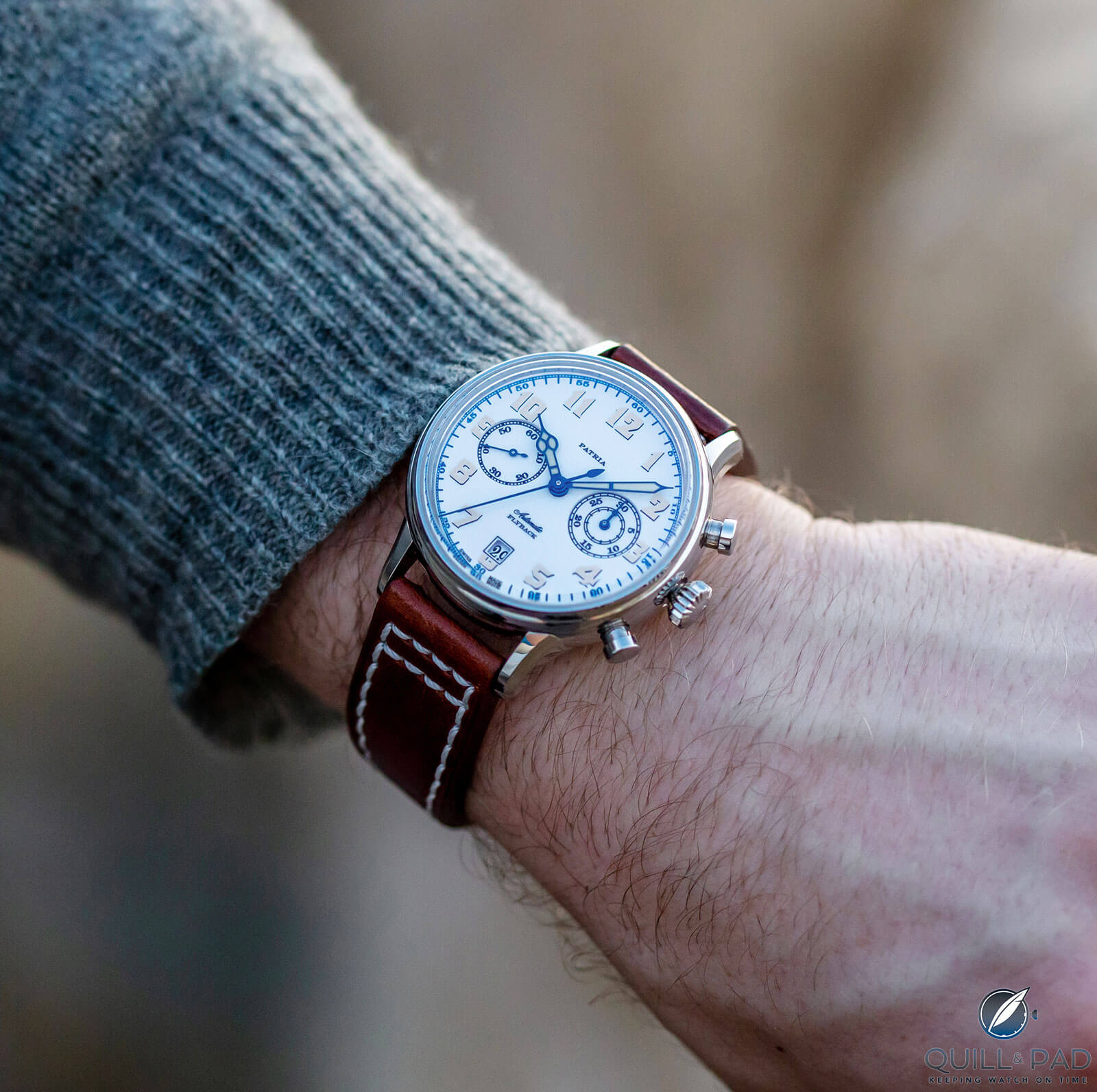
Patria Brigadier flyback chronograph on the wrist
Brandt’s original workshop was an établisseur, meaning that its core business was to assemble movements and pocket watches. Only after Louis Brandt’s death in 1879, did his children Louis-Paul and Charles-César choose to produce their own movements, changing the company’s form to that of a manufacture in 1880 and marketing their cylinder calibers in watches they called Jura, Helvetia, Celtic, Gurzelen, and Patria among others. The Omega brand name only came along in 1894 with the invention of a forward-thinking 19-ligne movement created specifically with serial production in mind.
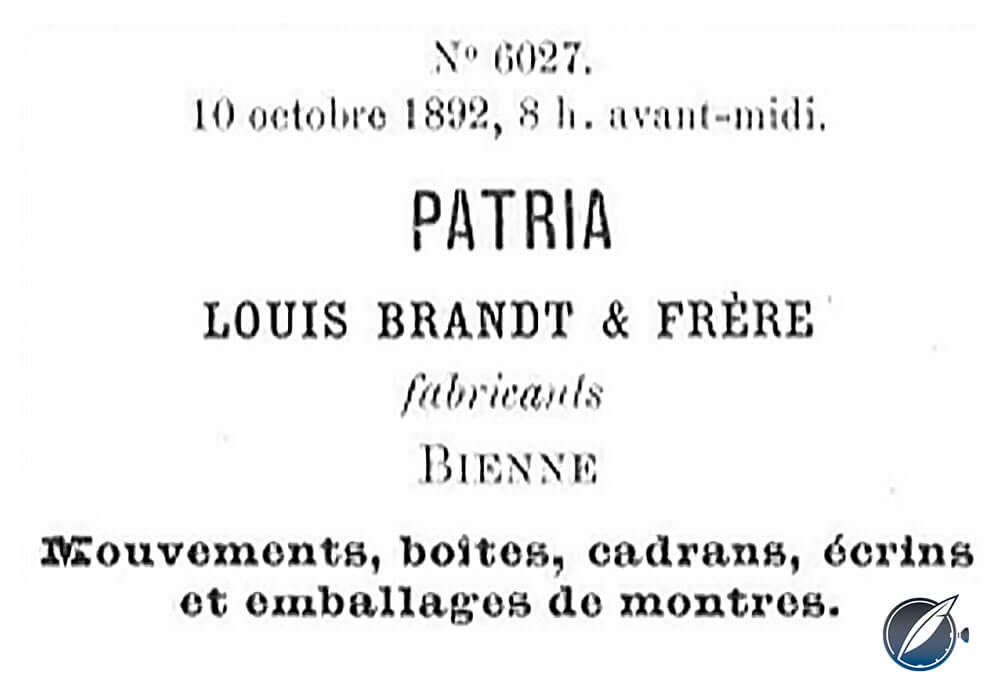
Patria’s original 1892 trademark
Louis Brandt & Fils trademarked the Patria brand on October 10, 1892 in Biel – where the sons had meanwhile relocated – citing its business as crafting “movements, cases, dials, presentation cases, and packaging.” In other words, the Brandts were now making the entire watch under one roof. And their intention with Patria was to explore the new market for wristwatches at a time when the pocket watch was still de rigueur.
At that time, wristwatches were mainly worn by fashion-forward women and a few military personnel, as a timepiece on the wrist was far more practical in the thick of battle than pulling a watch out of the pocket.
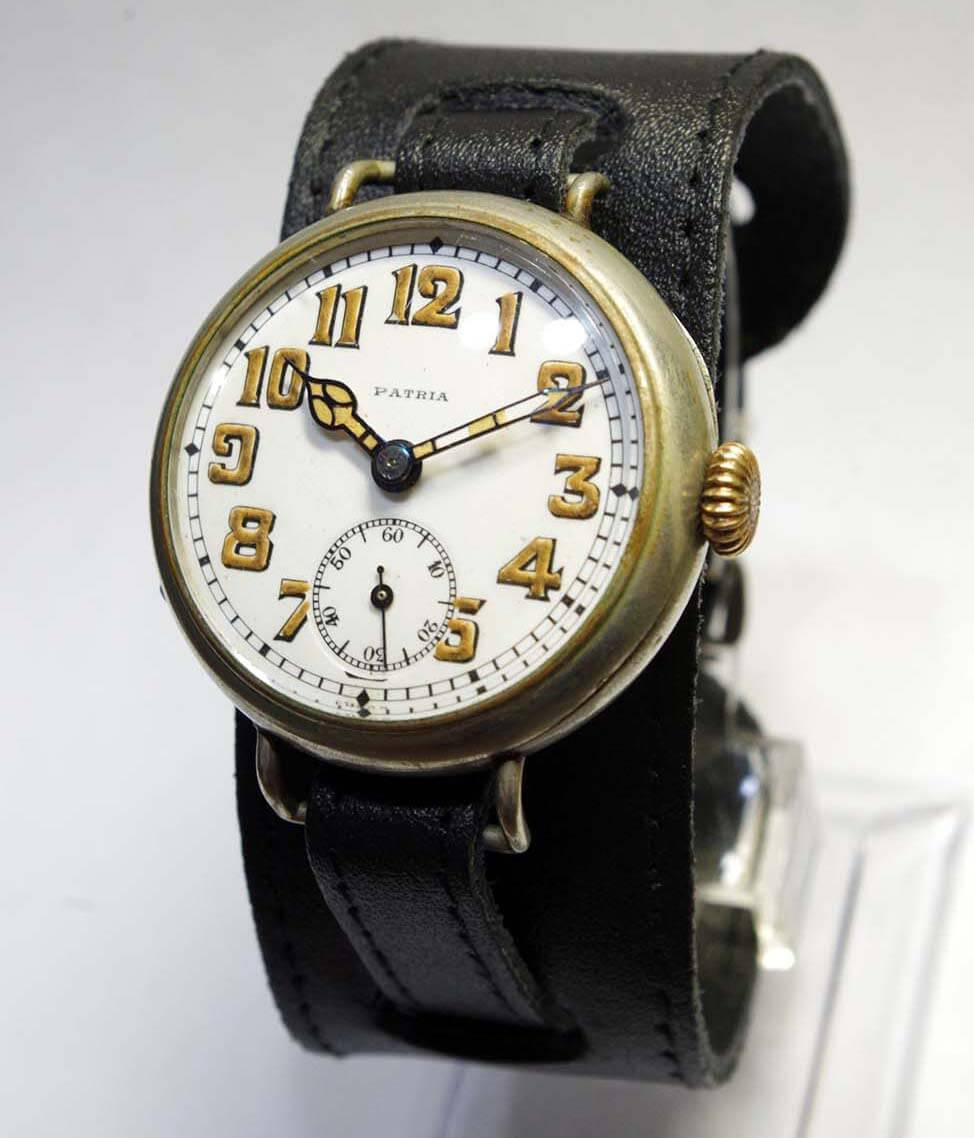
A Patria military trench watch from circa 1905 on a leather bund strap (photo courtesy Wikipedia / www.clevelandwatchrepair.com)
Patria was unusual in that it was a brand worn by soldiers, and the trench styling of the watches, which were usually cased in sterling silver or German silver, squarely reflected that military look, including radium-infused numerals standing out from porcelain dials for the best possible visibility. The movement was a Brandt nickel-plated 13-ligne caliber.
Unlike most other watch lines of its time, Patria watches were purpose-built to be worn on the wrist, not simply repurposed pocket watches with soldered-on lugs.
In the 1940s (with the entire industry making both wristwatches and wristwatches for the military) the Patria trademark seems to have been sold to Sada Montres SA in Biel (a brand the Brandts also exported). Then it fell into obscurity around the time of the quartz crisis – the trench watches becoming eBay treasure in the modern era.
Patria: a new beginning
The modern story of Patria begins with Jolyon Lambert, a 31-year-old British industrial designer who has worked with watches for the last few years, first by training in Swiss watch design and finally founding a company specializing in three-dimensional design and rendering of watches.
“I have actually wanted to start a watch brand since I was about 11 years old – strange kid in that regard – when I saw a friend of mine who had nicked his dad’s watch and wore it to school. This thing just got in my head from a really young age; I got really fascinated in Swiss watches and chronographs, the really instrumental look, and these vintage pilot-type watches,” Lambert opened as I met him for coffee one sunny day in Switzerland to see his prototype. “It just played around in my head, and I ended up studying product design and industrial design.”
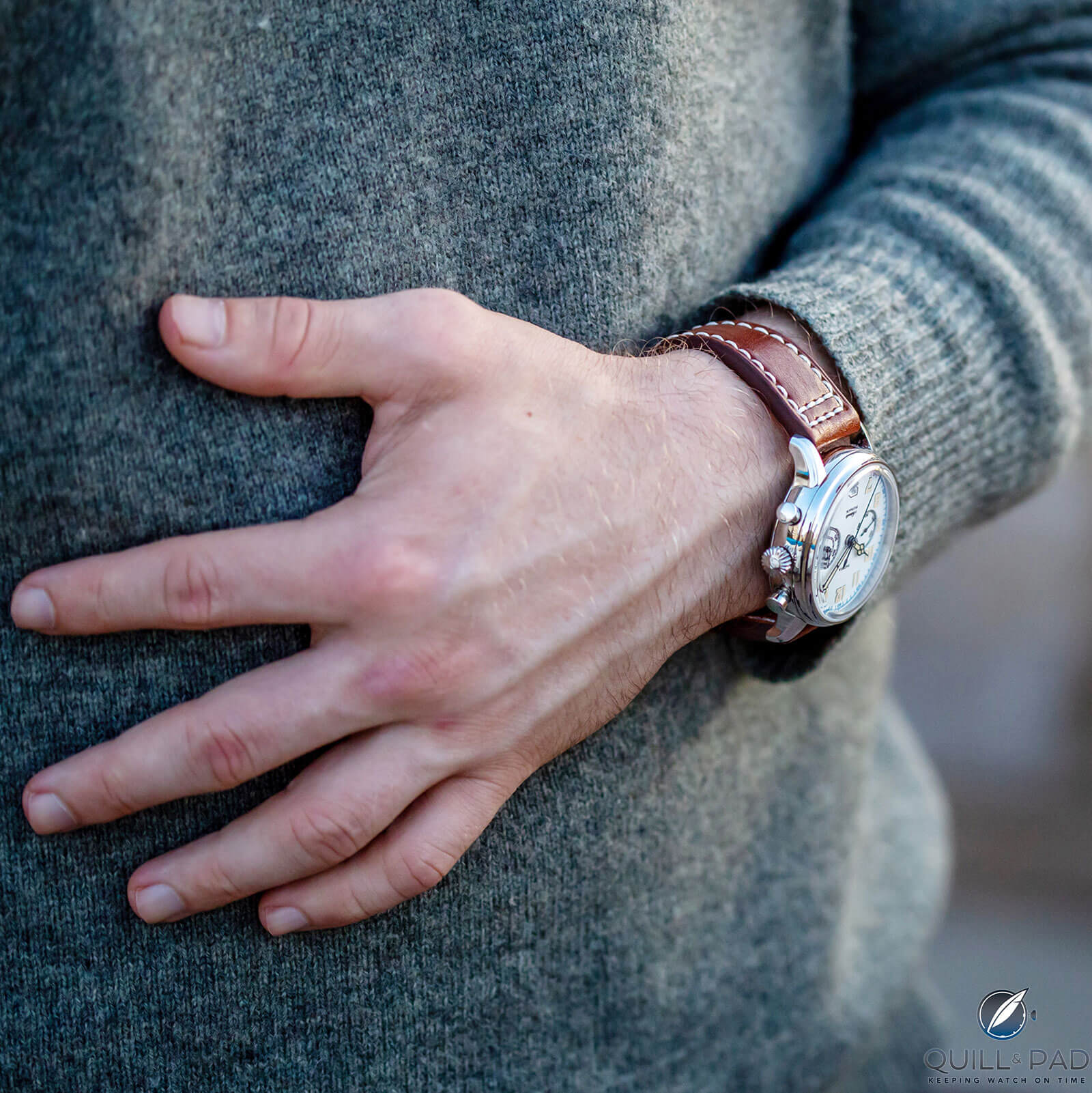
Patria Brigadier chronograph on the wrist
In his mid-twenties, Lambert was by his own admission faced with the stark reality that if he wanted to break into watches anytime soon, he would need to cold call every single Swiss watch company in the world that he could find – which he did, even offering to go Switzerland and work for free. Which is how he became a “long-distance apprentice” for an independent watch company before embarking upon a paid internship at Longines in industrial design.
Now, thanks to finding the right people to work with in the background in the form of established établisseurs, creative watchmakers, and investors, Lambert has made his dream into a reality.
And despite the modern practice of founding micro brands, the young designer is resolute about Patria becoming a “real” brand – even if his brand follows a certain a current trend in watches today: the vintage look.
“I’ve got a fascination with vintage watches, I’m a collector. I buy all kinds of really rare, weird watches,” Lambert admitted to me. “And if I were to bring back an important brand, I would, rather than ‘owning’ a company, see myself as being more of a legal custodian for something that already has some heritage and history. I don’t want to fake anything or make up history – there are so many brands doing this now, inventing things that don’t exist – but this brand, Patria, is special.”
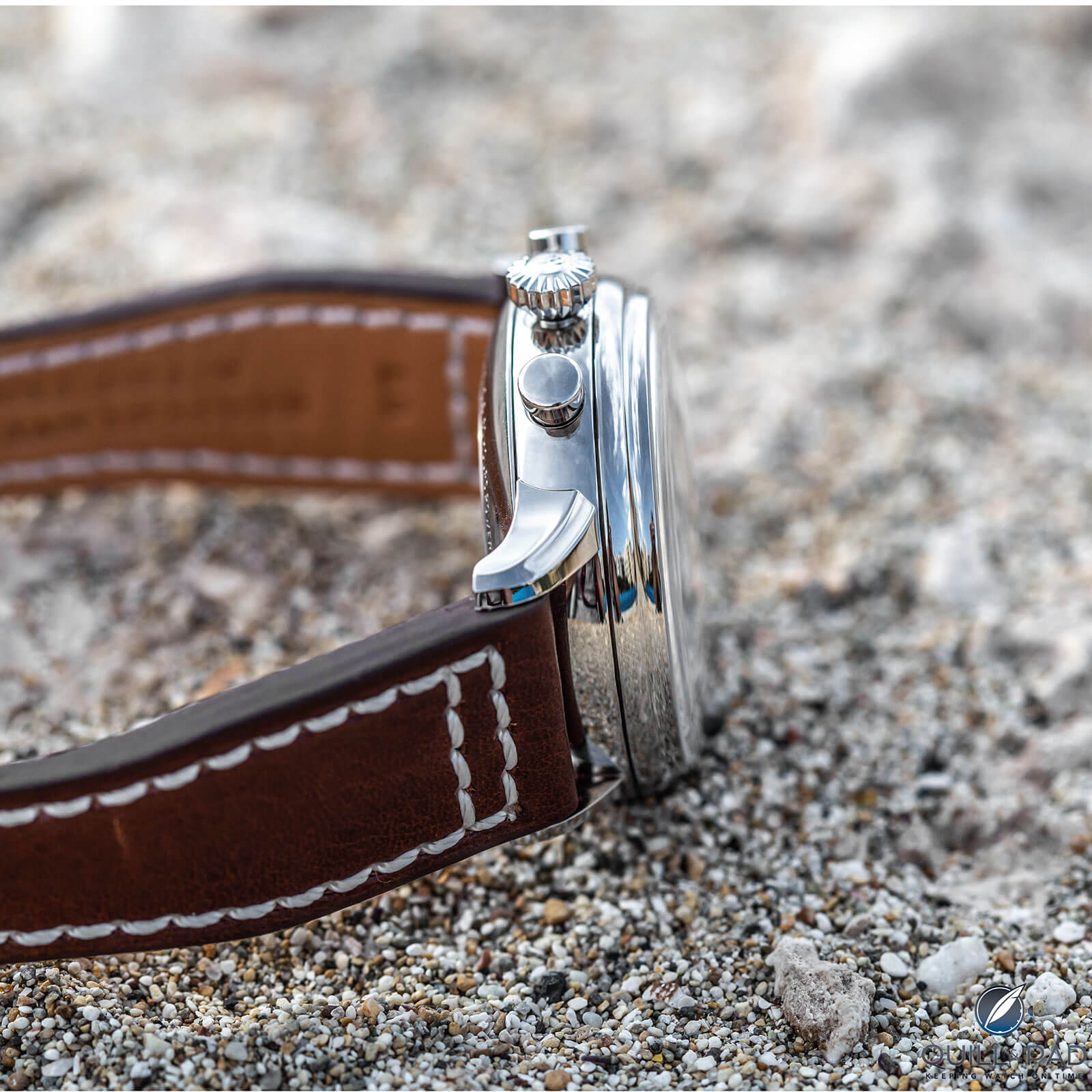
The high-quality lugs, pushers, and crown of the Patria Brigadier chronograph
Why Patria?
Lambert believes Patria has its own strength in that – unusually for the time – it was manufacturing its own calibers from day one in an industrial way. There were not many brands doing that at the time as the supplier system was prevalent (right up into the beginning of this century, as a matter of fact).
“And if you open up one of these vintage watches, [you see] that the movement is elegant, well considered, ahead of its time, and focused. Patria really focused its attention on two divisions: the Lépines and later the military trench and ladies’ watches, which came in square or octagon shapes.”
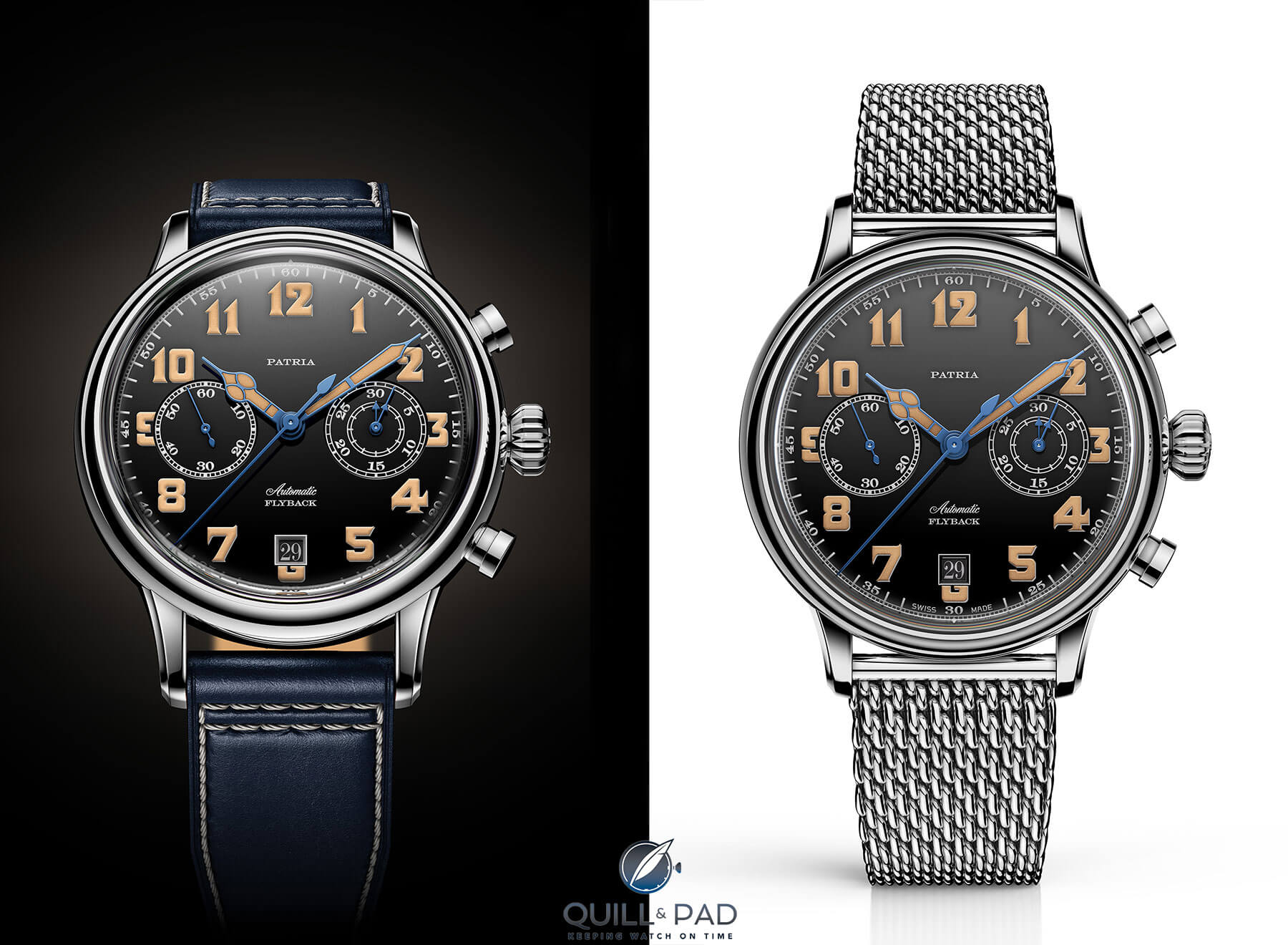
Renderings of the Patria Brigadier with black dial
Such shapes were typical for turn-of-the-century wristwatches: as the industry was transitioning away from pocket watches, manufacturers often used shapes other than round as they were purposefully making them as wristwatches (rather than repurposing pocket watches). Males didn’t generally like the shaped cases, and it took a long time for men to get used to the idea of wearing watches on the wrist at all.
As Patria was dormant after about the 1940s or ’50s, it completely missed the quartz era. “This means there are no horrendous Frankensteins out there waiting to emerge,” Lambert laughed. “The Patria watches have always been mechanical, purposeful, in-house watches: quality over quantity.
“It’s had its chapter one, and this is its chapter two.”
And Lambert stressed that he has no interest in doing what a lot of other brands do: simply regurgitate the past. “This is not a replica of an old Patria; this is a watch that uses Swiss watchmaking tradition, the techniques that make this country the best in the world in this field, but for a new product.”
In other words, Lambert feels that although this watch’s inner values – its technology – wouldn’t have been around in the Brandts’ day, to use them today would certainly have made the forward-thinking founders proud. “The new product is the best it can be with modern technology.”
Hands on with the Patria Brigadier column-wheel chronograph
The Patria Brigadier that I handled is an alpha prototype, meaning that it’s the earliest sample, and it had only been assembled the day before.
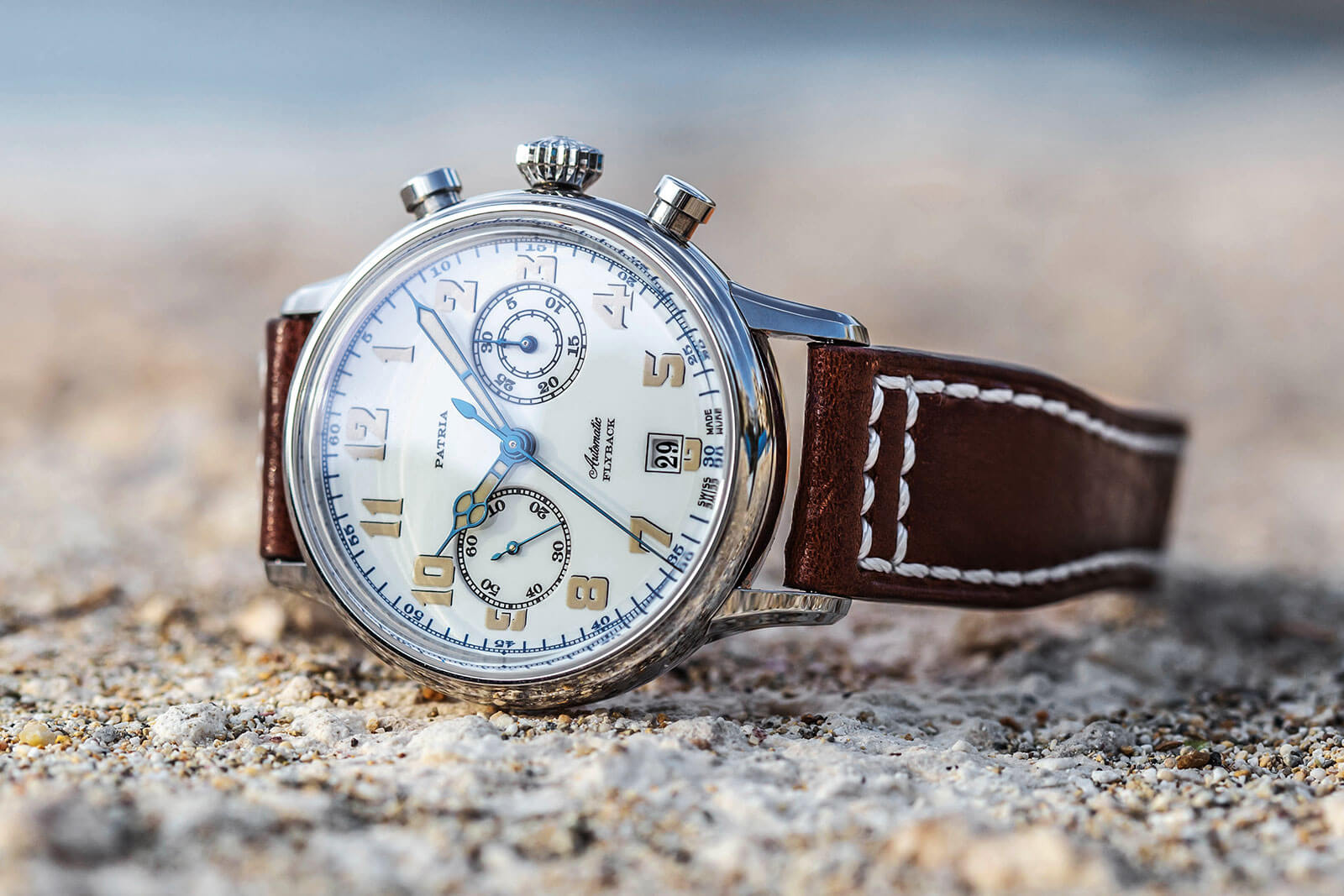
Patria Brigadier flyback chronograph with white dial
Date windows like the one at 6 o’clock found here are often subject to criticism from purists, but I personally find that as far as these things go, this date looks quite good.
The white-lacquered dial is dominated by vintage-style numerals and hands in a warm caramel color created by “Old Radium” Super-LuminNova. The luminous material – hand applied for a three-dimensional appearance – glows bright green in low light. A version with a black-lacquered dial will also be available.
I especially like the quality of the case, which is nice and smooth to the touch without any sharp angles, which is practically unheard of in a regular prototype (“It’s even mirror-polished on the inside,” Lambert gleefully explained). And while it might not be entirely visible on the photos, the lugs are a unique shape created to deter potential forgeries.
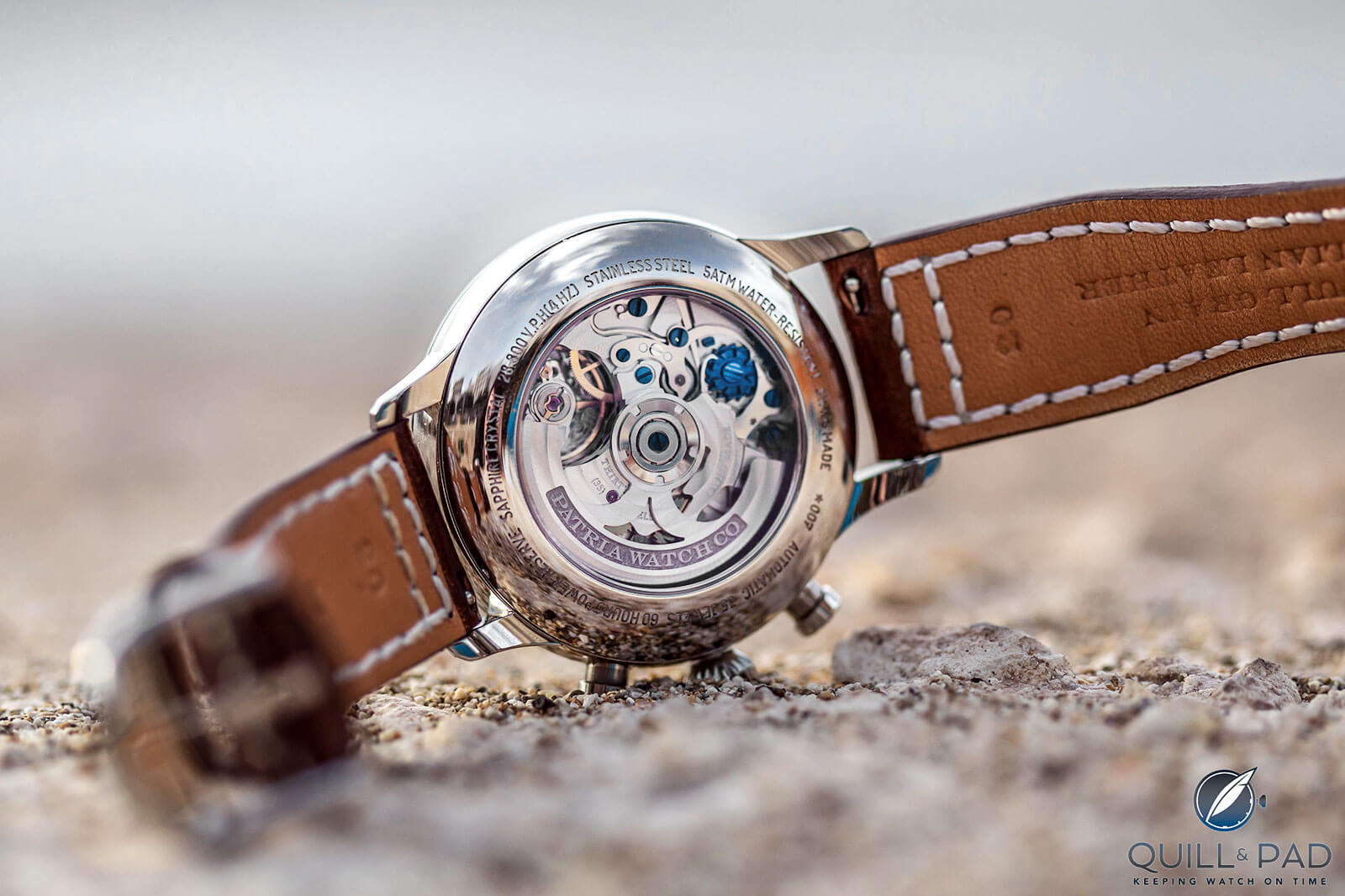
View through the display back of the Patria Brigadier flyback chronograph
And now we come to the movement: a well-finished flyback chronograph made by Eterna, which has been making its Caliber 39 movements available to outside brands since 2012. Caliber 39 is a movement with a semi-modular construction, and for Patria, Eterna has integrated a column-wheel chronograph.
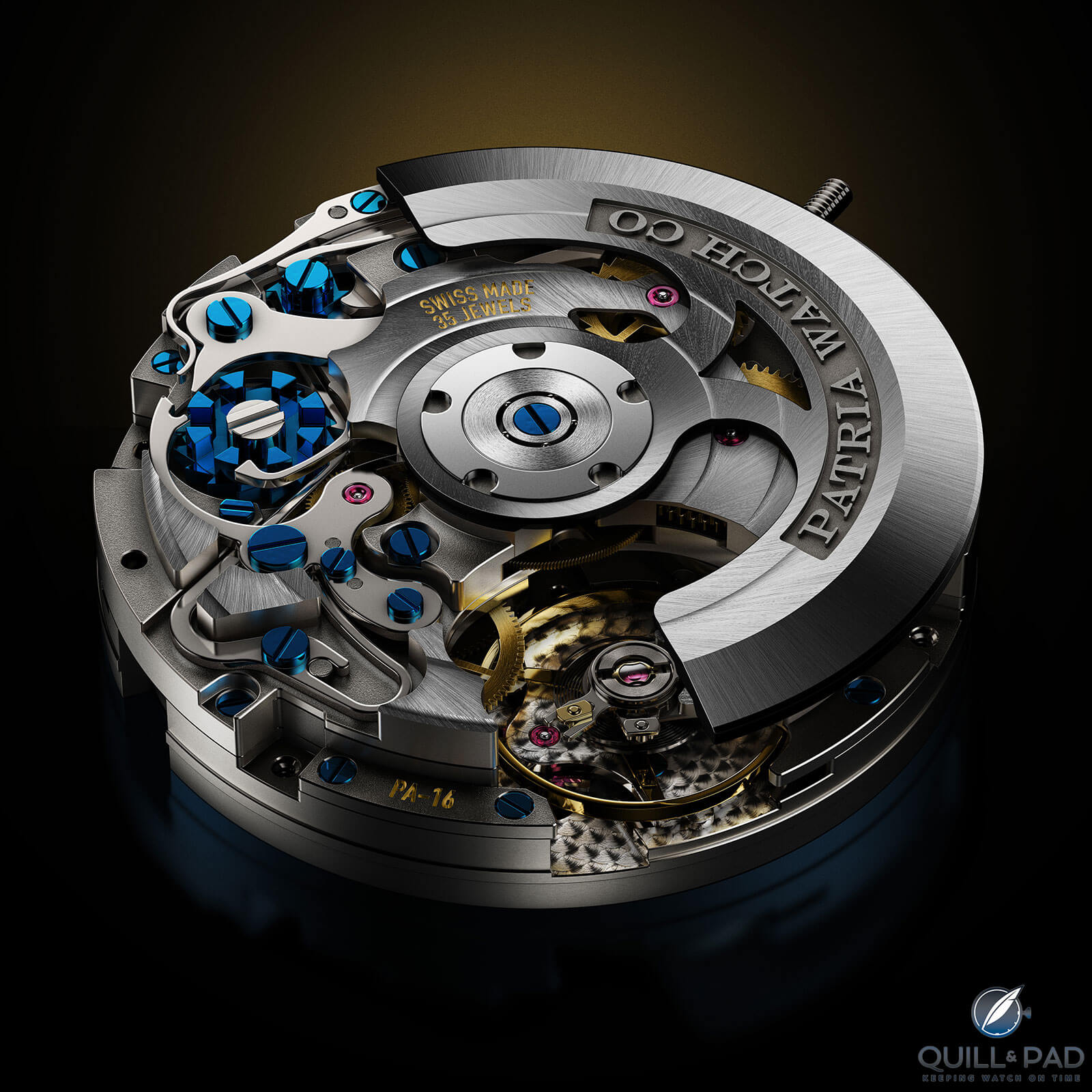
Patria’s PA-16 automatic movement with flyback chronograph
Watchmakers have told me that this is a reliable and easily serviceable movement. And it certainly isn’t one that you come across every day.
Patria has cut any corners here, either: the movement has 60 hours’ worth of power reserve and is dotted with beautiful heat-blued steel screws, column wheel, and flyback cam. The prototype also features a blued column wheel screw, though that center screw is planned to be natural steel on the final version.
The Patria Brigadier will be available in a limited edition of 92 pieces at launch. A star engraved next to the serial number marks them as the first watches to be manufactured by the revived Patria Watch Co.
The Patria Brigadier is the start of something new and potentially quite beautiful – rest assured this chronograph is by no means where this brand ends, either. In my opinion, having heard something of the pipeline intentions, Patria is a new brand worth watching.
For more information, please visit www.patriawatch.co.
Quick Facts Patria Brigadier Flyback Chrono
Case: 42 x 15.6 mm, stainless steel
Movement: automatic Caliber PA-16 (Eterna Caliber 3916), 60-hour power reserve, 4 Hz/28,800 vph frequency
Functions: hours, minutes, hacking seconds; date, flyback chronograph
Price: 5,285 Swiss francs (leather strap), 5,640 Swiss francs (mesh bracelet)
You may also enjoy:
Valjoux 7750: The World’s Greatest Chronograph Movement By Far (By Popularity And Numbers)
Here’s Why: The Chronograph Is The New Tourbillon
Discovery, Firsts, And The Louis Moinet Compteur De Tierces
Leave a Reply
Want to join the discussion?Feel free to contribute!



The launch of a future star in the watch industry! Both the watch & Lambert. I am not technical but I can see the perfection & absolute quality in this outstanding wristwatch & look forward to holding one in my hands.
Very excited about this piece. Patria is a giant returning to the horological world stage.